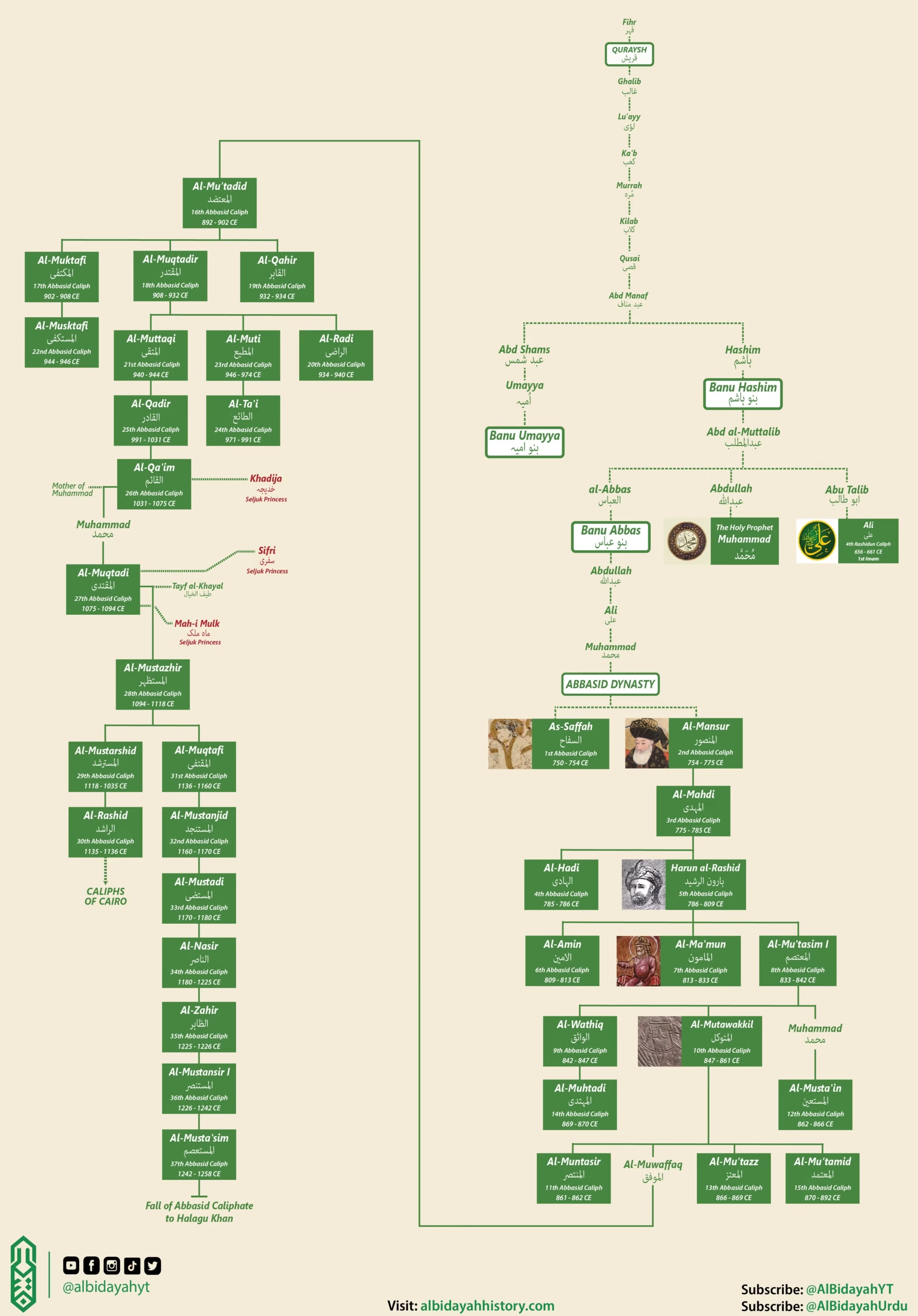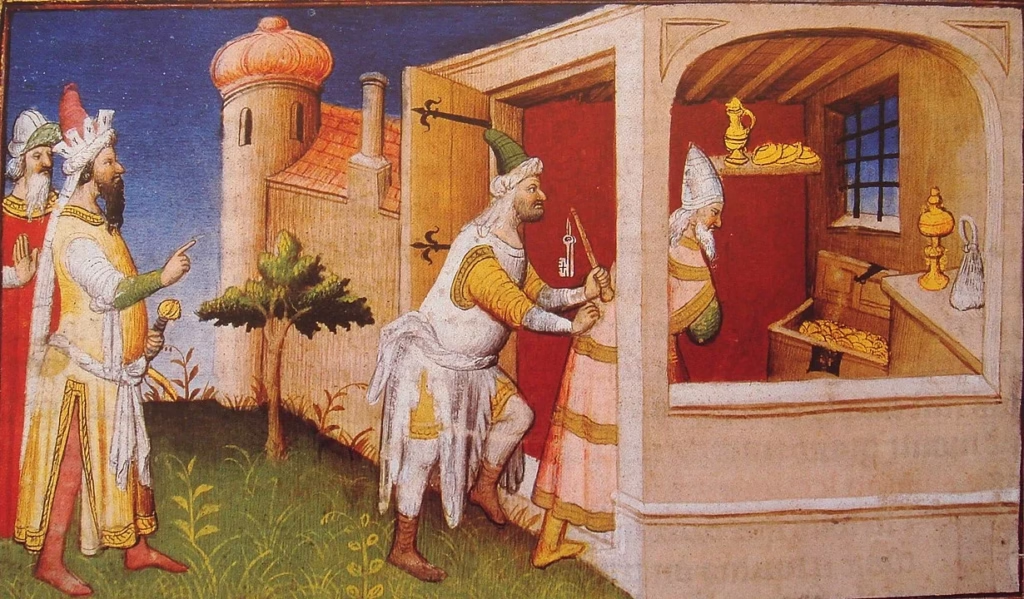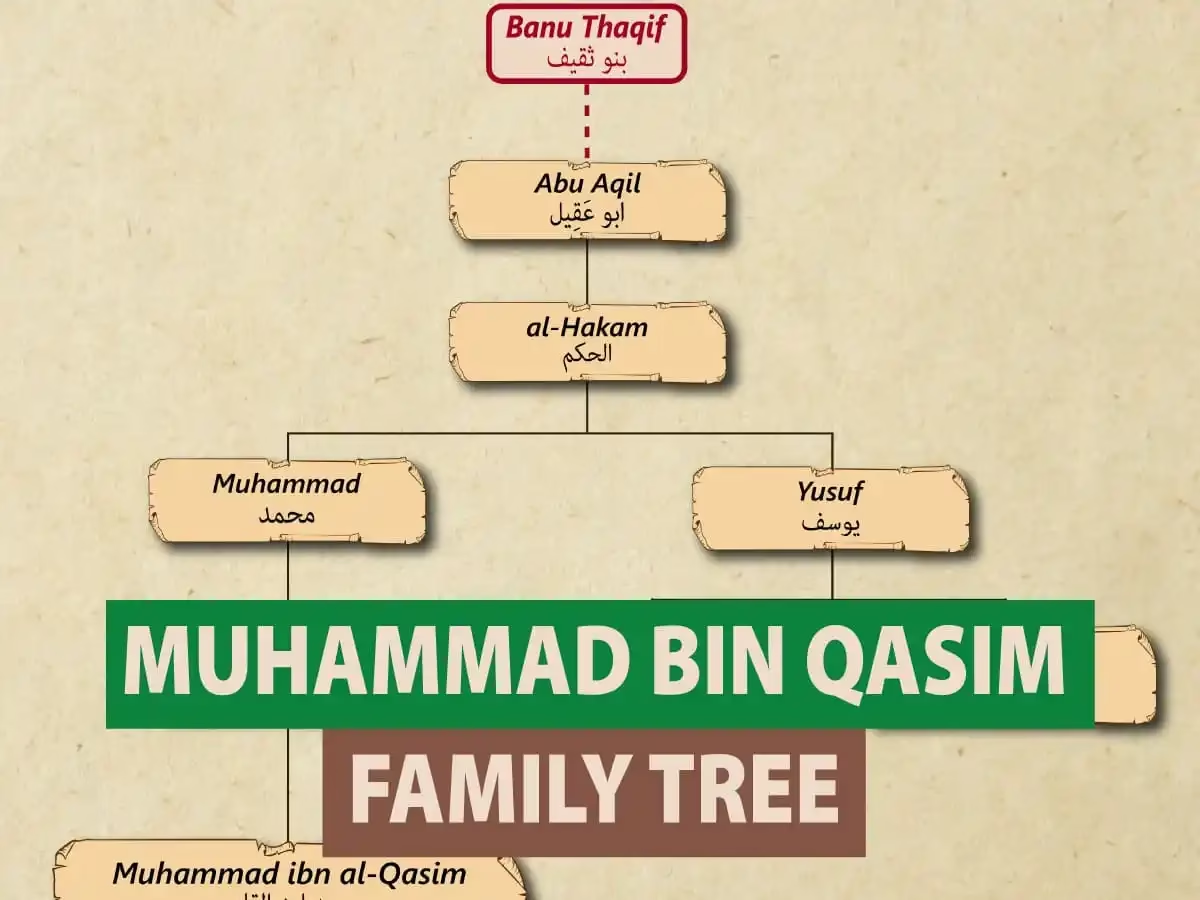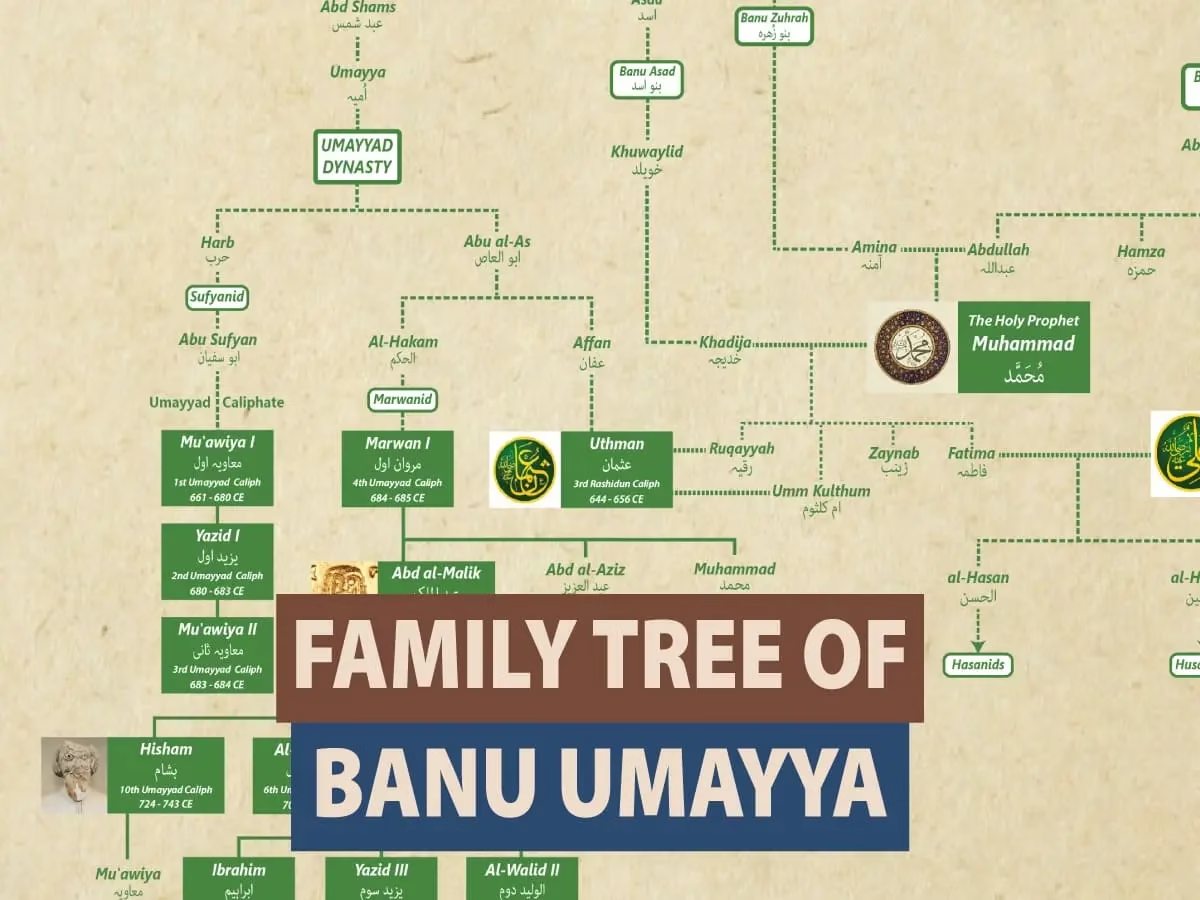The Banu Abbas family tree starts with Al-Abbas, the uncle of Prophet Muhammad (PBUH), establishing the lineage that led to the Abbasid Dynasty. Al-Abbas’s descendant Prophet Muhammad (PBUH) is the root of the Abbasid Caliphs. The dynasty begins with As-Saffah, the first Abbasid Caliph (750-754 CE), followed by his brother Al-Mansur (754-775 CE), who solidified Abbasid power. The line culminates with Al-Musta’sim (1242-1258 CE), the last Abbasid Caliph in Baghdad, who fell to Hulagu Khan, marking the end of the Abbasid Caliphate in Baghdad.

Ancestry
The Abbasids were descendants of Abbas, the uncle of Prophet Muhammad (PBUH) and an early scholar of the Qur’an. Their lineage traces back to Hashim ibn ‘Abd Manaf and further to Adnan, following this ancestral line:
Al-‘Abbas ibn Abdul-Muttalib ibn Hashim ibn Abd Manaf ibn Qusai ibn Kilab ibn Murrah ibn Ka’b ibn Lu’ay ibn Ghalib ibn Fihr ibn Malik ibn An-Nadr ibn Kinanah ibn Khuzaima ibn Mudrikah ibn Ilyas ibn Mudar ibn Nizar ibn Ma’add ibn Adnan.
See Also: Prophet Muhammad (PBUH) Family Tree: Quraysh to Imam Mahdi
The Abbasid Dynasty: Abbbasdi Calips in Baghdad
The Abbasids ruled as caliphs for most of the caliphate from their capital in Baghdad in modern-day Iraq, after having overthrown the Umayyad Caliphate in the Abbasid Revolution of 750 CE (132 AH).
• Al-Saffah: The Blood-Shedder
Al-Saffah, known as “the Blood-Shedder,” was the first Abbasid caliph. His rule began the Abbasid era by taking advantage of widespread resentment against the Umayyads, especially among non-Arab Muslims (mawali). To prevent the Umayyads from regaining power, he carried out a systematic purge. He also centralized authority in Kufa and started planning for the future Abbasid capital, which his successor later completed.

• Al-Mansur: The Builder of Baghdad
Al-Mansur, who ruled from 754 to 775 CE, is considered the true founder of the Abbasid Caliphate. He was a visionary leader who built a strong political and cultural center. His greatest achievement was founding Baghdad in 762 CE, a circular city symbolizing unity and becoming a center for trade, science, and art.
Beyond city-building, Al-Mansur was a skilled strategist. He secured Abbasid rule by defeating rebellions and strengthening the economy with smart financial policies. His leadership laid the foundation for the Islamic Golden Age.
• Harun al-Rashid: The Golden Age Caliph
Harun al-Rashid, who ruled from 786 to 809 CE, is one of the most celebrated figures of Islamic history. He established the famous library, Bayt al-Hikma (“House of Wisdom”), in Baghdad, which became a major center for knowledge, culture, and trade. During his rule, Baghdad flourished. Harun was a patron of scholars, artists, and writers, fostering an environment where ideas flourished. His reign is traditionally regarded to be the beginning of the Islamic Golden Age.

He freed many Umayyads and ‘Alids who had been imprisoned by his brother, Al-Hadi, and granted amnesty to all political groups from the Quraysh. However, his reign also saw large-scale conflicts with the Byzantine Empire. Under his leadership, the Abbasid Caliphate reached its greatest strength.
• Al-Ma’mun: The Philosopher Caliph
Abu al-Abbas Abd Allah ibn Harun better known by his regnal name, Al-Ma’mun was the seventh Abbasid caliph, ruling from 813 until his death. He became caliph after defeating his half-brother, al-Amin, in a civil war, which weakened the Abbasid Caliphate and led to many rebellions. Much of his rule was spent trying to restore order.
Al-Ma’mun was highly educated and had a great interest in knowledge. Al-Ma’mun promoted the Translation Movement, which helped spread science and philosophy in Baghdad. He also supported the mathematician al-Khwarizmi, whose work on algebra became famous. However, his rule was also marked by the Mihna, a religious inquisition, and the imprisonment of Imam Ahmad ibn Hanbal. He also resumed large-scale wars with the Byzantine Empire.
• Al-Mutawakkil: The Conservative Reformer
Al-Mutawakkil was the tenth Abbasid caliph, ruling from 847 to 861 CE. He succeeded his brother, al-Wathiq, and expanded the empire to its largest size. He was very religious and is known for ending the Mihna (a time when scholars were persecuted) and freeing the famous scholar Imam Ahmad ibn Hanbal.

He is also known for his tough rule, especially with respect to non-Muslim subjects. He was assassinated on 11 December 861 by the Turkic guard with the support of his son, al-Muntasir, marking the beginning of the period of civil strife known as the “Anarchy at Samarra“.
• Al-Musta’sim: The Last Abbasid Caliph of Baghdad
The last Abbasid caliph of Baghdad, Al-Musta’sim ruled from 1242 to 1258, faced one of the darkest chapters in Islamic history. Despite his efforts to maintain Abbasid rule, the Mongol invasion led by Hulagu Khan proved unstoppable. The sack of Baghdad in 1258 CE marked the end of the Abbasid Caliphate as a political power.

Other Abbasid Caliphs
- Al-Musta’in (862–866) – Reigned during the Anarchy at Samarra; civil war with Al-Mu’tazz led to his deposition.
- Al-Mu’tazz (866–869) – Last powerful Abbasid caliph in Samarra; deposed by Turkic military officers.
- Al-Muhtadi (869–870) – Emulated Umar ibn Abd al-Aziz; assassinated by Turkish military, ending the Anarchy at Samarra.
- Al-Mu’tamid (870–892) – Abbasid revival begins; Zanj Revolt crushed, Tulunids emerge in Egypt, gradual territorial decline.
- Al-Mu’tadid (892–902) – Strong ruler; expanded Abbasid control, moved capital back to Baghdad, faced Qarmatian raids.
- Al-Muktafi (902–908) – Recovered Egypt and Syria from the Tulunids; end of the Abbasid revival.
- Al-Muqtadir (908–932) – Youngest caliph; decline continues, Fatimids and Córdoba challenge Abbasid authority.
- Al-Qahir (929, 932–934) – Brief reigns; installed and deposed twice, known for cruelty.
- Al-Radi (934–940) – Last real caliph with authority; political power shifts to military leaders.
- Al-Muttaqi (940–944) – Chosen by military; overthrown and blinded by Amir al-Umara Tuzun.
- Al-Mustakfi (944–946) – Installed by Tuzun, deposed by Buyids, marking their dominance.
- Al-Muti (946–974) – Buyid influence grows; Abbasids lose Egypt, Palestine, and Hejaz.
- Al-Ta’i (974–991) – Deposed by Buyids; Fatimids and Byzantines weaken Abbasid authority.
- Al-Qadir (991–1031) – Installed by Buyids; formalized the title “Sultan” for Muslim rulers.
- Al-Qa’im (1031–1075) – Seljuks take Baghdad, ending Buyid rule; Abbasids regain religious prestige.
- Al-Muqtadi (1075–1094) – Recognized by Seljuks; Abbasids regain control over Hejaz.
- Al-Mustazhir (1094–1118) – Faced the First Crusade; supported resistance against Crusaders.
- Al-Mustarshid (1118–1135) – First Abbasid caliph to challenge Seljuks militarily; assassinated.
- Al-Rashid (1135–1136) – Deposed by Seljuks, later assassinated by Nizari Ismailis.
- Al-Muqtafi (1136–1160) – Strengthened Abbasid military, repelled Seljuk siege of Baghdad.
- Al-Mustanjid (1160–1170) – Succeeded his father; faced continued Seljuk influence.
- Al-Mustadi (1170–1180) – Granted Saladin the title “Sultan”; Abbasid influence in Egypt restored.
- Al-Nasir (1180–1225) – Last effective Abbasid caliph; recognized by Ayyubids, opposed Mongols.
- Al-Zahir (1225–1226) – Brief reign; built a strong army, saw early Mongol invasions.
- Al-Mustansir (1226–1242) – Faced Mongol invasions; Bukhara and Samarkand destroyed.
Abbasid Caliphs of Cairo (1261-1517)
In 1261, the Abbasid dynasty was revived in Cairo under the rule of the Mamluk Sultans. However, these Abbasid caliphs had only religious and symbolic roles, while real power was held by the Mamluks. This revived Abbasid Caliphate in Cairo lasted until 1517 when the Ottomans conquered Egypt and took the caliphal title. The Cairo Abbasids mainly served as ceremonial leaders under the Mamluks, following the end of the Ayyubid dynasty.



